

 |
 |
 |
 |
 |
 |
 |
| As they are developing curricula
and facilities that will address the educational needs of the 21st century,
engineering faculty at the University
of Notre Dame are shifting their focus from teaching students to helping
them learn. Local residents huddled along one of the University of Notre Dame’s main roads in January were waiting to see the Olympic torch as it swept through the South Bend area on its way to Salt Lake City for the 2002 Winter Olympic Games. Rev. Theodore M. Hesburgh, C.S.C., president emeritus of the University, and Debbie Brown, Notre Dame head volleyball coach, were two of the 34 honorary torch-bearers who carried the Olympic flame along South Bend’s nearly seven-mile leg of the 13,500-mile journey. By the time it reached Salt Lake City on February 2, the torch had passed through 46 states and 11,500 pairs of hands. In The Republic Plato said, “Those having torches will pass them on to others.” But he wasn’t talking about the Olympic flame. He was describing a process, the way ideas are conveyed from one person to another. The interaction that takes place between teacher and student and among groups of students is more dynamic than a simple hand-off. The educational process requires planning, continuity, community, excitement, and a vision for the future. 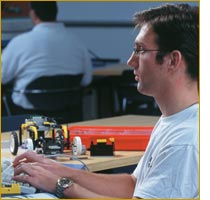 These are the elements the College of Engineering is pursuing as it continues
its plans for the development of a multidisciplinary engineering learning
center. “If you look at the technical advances of the last century,” says
Stephen M. Batill, associate dean for
educational programs and professor of aerospace and mechanical engineering, “wireless
worldwide communications, the development of medical therapies and devices
that enhance the length
and quality of life, and the creation of materials designed to perform
specialized functions -- they are the kinds of activities that come
about from people who not only understand engineering systems as a whole,
but who also work together as a community. We expect that an engineering
learning center will help students understand the necessity and benefits
of collaboration. More important, we hope that the multidisciplinary
perspective and environment fostered by the center will help our students
become the leaders and innovators for the next great advancements.” These are the elements the College of Engineering is pursuing as it continues
its plans for the development of a multidisciplinary engineering learning
center. “If you look at the technical advances of the last century,” says
Stephen M. Batill, associate dean for
educational programs and professor of aerospace and mechanical engineering, “wireless
worldwide communications, the development of medical therapies and devices
that enhance the length
and quality of life, and the creation of materials designed to perform
specialized functions -- they are the kinds of activities that come
about from people who not only understand engineering systems as a whole,
but who also work together as a community. We expect that an engineering
learning center will help students understand the necessity and benefits
of collaboration. More important, we hope that the multidisciplinary
perspective and environment fostered by the center will help our students
become the leaders and innovators for the next great advancements.”The concept of a multidisciplinary learning center started as a seed, a glimmer of an idea, generated by the College’s Curriculum Enrichment Committee in 1999 to address the changes occurring in the engineering profession and in engineering education. Over the last 15 years more and more employers have been emphasizing that a successful engineer should not only have strong technical capabilities in a specific discipline, but that he or she should also possess the knowledge of how interdependent elements function in an engineering system, exhibit solid communication skills, and have experience working as a member of a multidisciplinary team. In its report the Curriculum Enrichment Committee recommended that these skills and experiences would be developed more effectively through interactive project-based learning -- integrating the subject matter from a variety of engineering disciplines and introducing mathematical and scientific concepts in the context of actual applications -- rather than through traditional, single-discipline lecture-based teaching. The committee then proposed that the best time to lay the foundation for “multidisciplinary, hands-on learning” was during the first year of a student’s engineering experience. Accordingly, the college’s role in the First Year of Studies program for engineering intents was significantly changed. A two-course sequence, EG111 and 112, replaced a computer programming course and includes a historical perspective on the engineering profession; exposure to engineering professionals from various disciplines; team-based design activities; and project-based analysis, modeling, and simulation exercises. In addition to developing EG111 and 112, the committee urged the college to adopt a “learning paradigm” marked by active student participation in educational activities. The approach also focuses on developing student leadership qualities and a team mindset, as well as strong technical skills, including the ability to effectively use information technology. It also encourages increased synergy among students and between students and faculty. According to the committee, both the first-year course sequence and an emphasis on experiential learning throughout the curriculum would require a specialized facility. 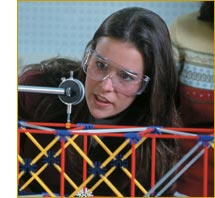 If students were to have the opportunity to learn through hands-on experiences,
to develop interdisciplinary projects, and to interact with other students
and faculty throughout the college, regardless of discipline or class,
they needed a place for this to occur. If faculty were to develop 21st-century
teaching and learning activities that would stimulate and inspire students
to work individually and in teams, they needed a place for this to occur.
If students and faculty were to become a community, working together,
and
at times with industry, to explore existing and emerging technologies
in a manner that would spark innovation and discovery, they needed a
place for this to occur. That place, according to the committee, was
an engineering learning center. If students were to have the opportunity to learn through hands-on experiences,
to develop interdisciplinary projects, and to interact with other students
and faculty throughout the college, regardless of discipline or class,
they needed a place for this to occur. If faculty were to develop 21st-century
teaching and learning activities that would stimulate and inspire students
to work individually and in teams, they needed a place for this to occur.
If students and faculty were to become a community, working together,
and
at times with industry, to explore existing and emerging technologies
in a manner that would spark innovation and discovery, they needed a
place for this to occur. That place, according to the committee, was
an engineering learning center.Development of a multidisciplinary learning center, as proposed by the committee, began as a two-phase process. Phase I called for the creation of a prototype facility, which would provide intermediate support for the needs of the College of Engineering and students in EG111 and 112. The prototype would also function as a working model of a much larger learning center, which would be developed as part of a new building project, Phase II. Phase I was completed in September 2000, when a prototype facility was opened in the Cushing Hall of Engineering. Developed at a cost of approximately $950,000, the 4,000-sq.-ft. learning center is a unique combination of computer cluster, design studio, laboratory, reference center, multimedia/presentation area, and study space. Its mission is to nurture a community environment where students and faculty are connected through their search for knowledge and quest to engineer better products and processes. 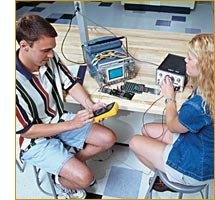 The prototype center is multifunctional, providing flexible work areas
for a variety of activities. Although created with first-year students
in mind, it can be, and is being, used by students at all levels and
in every department of the college to explore, experiment, and experience
the many facets and disciplines of engineering. For example, students
in the learning center can work individually or in teams on discipline-specific
projects. They can also pool their skills, using group work areas with
networked computer support and multiple screen audio-visual capabilities,
to complete a multidisciplinary class assignment. The prototype center is multifunctional, providing flexible work areas
for a variety of activities. Although created with first-year students
in mind, it can be, and is being, used by students at all levels and
in every department of the college to explore, experiment, and experience
the many facets and disciplines of engineering. For example, students
in the learning center can work individually or in teams on discipline-specific
projects. They can also pool their skills, using group work areas with
networked computer support and multiple screen audio-visual capabilities,
to complete a multidisciplinary class assignment.Although there are similar centers at a handful of universities across the country, the college’s facility is unique in two very important ways. First, it offers a wide variety of tools and resources to students and faculty in the college, many of which are not easily accessible to students at other institutions. Also, while it functions primarily as a student learning center, the prototype facility provides faculty the opportunity to develop and test novel teaching and learning techniques. “The real beauty of the learning center is that the space is so dynamic,” says Batill. “Different people can use it in a multitude of ways at the same time.” And, that’s exactly what’s happening. Junior chemical engineering students are completing work for a fluid mechanics course at the same time first-year students are reviewing their notes for the next day’s truss project. When the prototype was opened, there was plenty of room for anyone wanting to use the center. Original operating hours were set from 9:00 a.m. to 10:00 p.m., Monday through Friday, and 10:00 a.m. to 10:00 p.m., Saturday and Sunday. The College has expanded hours once and is currently considering adding more hours during the evenings and on weekends. “What’s been very exciting for me,” says Natalie Gedde, the learning center manager, “is being able to see how many students not involved in EG111 and 112 are using the learning center. Watching them get excited about the resources available here confirms that we’re on the right track.” Gedde also notes the number of students who gather in the center for group projects has increased dramatically since the beginning of the year. In fact, several courses from each department now require that specific projects be conducted in the learning center. Some courses have held oral presentations in the center, making use of the facility’s audio-visual capabilities and presentation area. Other classes use the center for software tutorials. Individually, students can check out portable learning modules. These multidisciplinary modules, supported by a grant from the General Electric Fund, complement classroom activities by helping students explore the interfaces between disciplines in devices such as an embedded microcontroller or processes like the flow of chemicals and contaminants in groundwater. Students using the modules can work at their own pace while expanding their educational experiences. “What we’re seeing in the learning center,” says Batill, “is an increased use of the facility, by students and faculty, as a learning tool. There is an excitement and a spirit of cooperation and communication in the learning center that is beginning to echo throughout the college.” 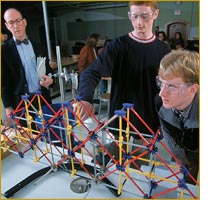 And, of course, the Introduction to Engineering Program uses the center
during the summer for its bridge and robotics projects. The high schoolers
in this program enjoy the center almost as much as their parents enjoy
the center’s web cam. Parents, school friends, and others are able
to watch activities in the center by logging onto the center’s
live camera at http://www.nd.edu/~englearn/webcam/webcam.htm. And, of course, the Introduction to Engineering Program uses the center
during the summer for its bridge and robotics projects. The high schoolers
in this program enjoy the center almost as much as their parents enjoy
the center’s web cam. Parents, school friends, and others are able
to watch activities in the center by logging onto the center’s
live camera at http://www.nd.edu/~englearn/webcam/webcam.htm.As successful as the prototype has been in launching EG111 and 112 and the new learning paradigm, there is more to be done. Engineering problems and technologies have become extremely complex and multifaceted. “Students who have participated in multidisciplinary, experiential, interactive, and team-based learning activities are those we believe,” says Batill, “who are better prepared, have a better understanding of what engineering is as an academic discipline and profession, and are more committed not only to the major, but also to building teams that address societal needs.” Unfortunately, measuring if students are better prepared for careers in engineering or more successful in their careers because of the “learning by doing” focus is not an easy task. As Batill and researchers from the University’s Kaneb Center for Teaching and Learning work to create meaningful devices for measurement, the college is continuing to develop plans for a 15,000-sq.-ft. learning center, which will be housed in a new engineering facility, the Multidisciplinary Engineering Education and Research Building. “The purpose of the new building,” says Frank P. Incropera, McCloskey Dean of Engineering, “is much broader in scope than simply the need for space. It’s about developing innovative and effective learning environments and communities. It’s also about creating a seamless transition between education and research, one that will benefit our students, faculty, industry partners, and society.” It is this vision for the future that is driving plans for the new building. 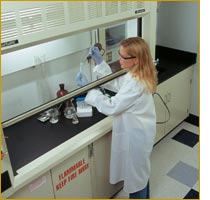 The learning center in the new building will provide cutting-edge design,
fabrication, and presentation facilities; interactive learning modules;
and even more hands-on engineering experiences than those available in
the current center. As in the prototype, students in the new learning
center will be able to work individually and in teams on a variety of
cross-disciplinary projects. The fact that there will be no “walls” between
disciplines in the center will foster the development of an engineering
community among undergraduates, graduate students, and faculty throughout
the college, encouraging interaction and collaboration. The learning center in the new building will provide cutting-edge design,
fabrication, and presentation facilities; interactive learning modules;
and even more hands-on engineering experiences than those available in
the current center. As in the prototype, students in the new learning
center will be able to work individually and in teams on a variety of
cross-disciplinary projects. The fact that there will be no “walls” between
disciplines in the center will foster the development of an engineering
community among undergraduates, graduate students, and faculty throughout
the college, encouraging interaction and collaboration.Facilities in the new center will include computer clusters for simulation and design activities, equipment for fabricating and testing prototypes, facilities for conducting experiments, a multimedia presentation area, demonstration areas, and group project work and study space. Although plans are not finalized, preliminary requirements for the new facility have been drafted by the Engineering Learning Center Steering Committee -- a group comprised of faculty, graduate students, and undergraduates from each department. Proposed elements of the center include: • Workstations in open areas supporting individual and small-group activities using a wireless computer network. • Shelf and table space allowing for use of instrumentation, data acquisition systems, and other equipment needed for student projects. • Fume hoods, chemical disposal sinks, vacuum and pressurized air, gas, and other chemicals for specialized activities. • A flexible multimedia presentation area offering teleconferencing and distance-learning capabilities for groups of up to 50 people. • Small group work areas, for up to eight students, offering network access, white boards, and conference tables. • A student shop supporting machining, computer-aided machining and rapid prototyping, and electronic assembly and testing equipment. • Computer clusters/classrooms supporting computer-aided design simulations, virtual prototyping, and information retrieval for small groups or individuals. • A multimedia resource area with preparation and practice rooms, as well as viewing capabilities for videos, CDs, etc. • Student storage space for completed projects, equipment, and other engineering artifacts. • Precision electronic and optical instruments for student projects. As an important extension of the learning center, the Multidisciplinary Engineering Education and Research Building will also house a commons area. Plans for the commons include a large atrium, coffee house, internet access ports, modern audio-visual equipment, and white boards, all of which will foster dialogue and the development of an educational and research community, one that is truly multidisciplinary in nature. The commons will encourage collaboration as faculty and students gather there to discuss specific projects or engineering concepts, interacting on a social level while connecting on a professional one. The commons and the learning center will be two vital parts of an active and productive engineering community. Sharing the new building will be two University centers: the Center for Nano Science and Technology and the Center for Molecularly Engineered Materials, which will also house the College of Engineering’s Materials Characterization Facility. The location of these two research centers within the new building and in such close proximity to the learning center will further strengthen the ties between teaching and research. In fact, one of the most exciting aspects of the new building is that state-of-the-art laboratories and research facilities will be fully integrated with state-of-the-art teaching and learning facilities. Students at all levels and across all disciplines will benefit from the exchange of ideas that will occur in a building where traditional boundaries have no meaning. They will experience firsthand the excitement of what it means to be part of an engineering community. 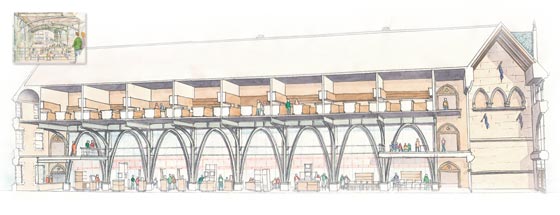 Most important, at the end of each undergraduate’s time at this
University, he or she will not say, “I’ve been studying to
be an engineer.” No ... as a Notre Dame engineering student each
graduate will have served as a vital member of a multidisciplinary team
on a classroom project,
as an undergraduate research assistant, or through an engineering internship.
Each will have made multiple presentations to classmates, faculty, and
even industry representatives. Each student will, in essence, be able
to lift his or her torch very high and say, “I am an engineer.” Most important, at the end of each undergraduate’s time at this
University, he or she will not say, “I’ve been studying to
be an engineer.” No ... as a Notre Dame engineering student each
graduate will have served as a vital member of a multidisciplinary team
on a classroom project,
as an undergraduate research assistant, or through an engineering internship.
Each will have made multiple presentations to classmates, faculty, and
even industry representatives. Each student will, in essence, be able
to lift his or her torch very high and say, “I am an engineer.”For more information about the Engineering Learning Center, visit http://www.nd.edu/~englearn. |